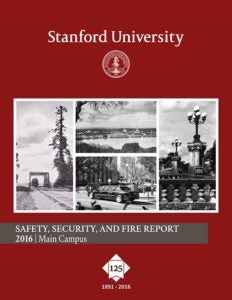Stanford releases 2016 Safety, Security and Fire Report
 While the number of reported campus robberies and aggravated assaults dropped to zero last year, Stanford’s 2016 Safety, Security and Fire Report showed an increase in reported sexual offenses as well as increases in drug and alcohol arrests.
While the number of reported campus robberies and aggravated assaults dropped to zero last year, Stanford’s 2016 Safety, Security and Fire Report showed an increase in reported sexual offenses as well as increases in drug and alcohol arrests.
According to the report, 39 sexual offenses were reported in 2015 to university staff who are required to report these offenses for statistical purposes, compared with 30 in 2014. In 2015, police made 20 arrests for reportable drug violations, compared with 7 in 2014. The report indicates the police made 70 arrests for alcohol-related crimes in 2015, an increase over arrests made in 2014.
Stanford Police Chief Laura Wilson attributed the rise in the total number of sexual offenses reported to campus police in 2015 to increased national attention on the issue of sexual assaults on college campuses, and to Stanford’s active efforts in recent years to combat sexual violence and provide support to those who experience it.
“The goal is to eliminate all forms of violence, including sexual violence, but we know these crimes are taking place. Reporting higher numbers is preferable to reporting lower numbers if the lower numbers mean people who have experienced prohibited or criminal conduct have chosen not to report the conduct,” Wilson said.
Wilson understands and respects the decisions individuals make about how to proceed after experiencing an incident of prohibited conduct, but wishes more victims would come forward and be willing to pursue some type of an investigation or proceeding. “A significant percentage of the reported sexual assaults were reported by someone other than the victim,” she said. “Further, a high percentage of victims choose not to report to the police, or to identify the alleged perpetrator to the university, or to participate in a university process.”
Wilson said that while the number of alcohol arrests on campus rose in 2015, the previous year’s numbers were unusually low: “The number of alcohol-related arrests in 2015 was similar to the numbers of arrests in 2013. We had a decrease in the number of alcohol arrests in 2014.
“One of the aspects of our crime reporting that is not well understood is that the statistics are not limited to the main campus or to crimes involving students, faculty and staff. They are for the entire campus – including visitors and people who are on campus for a camp or conference – as well as property owned and managed by the university.
“For purposes of data reporting, the Stanford Hospitals, SLAC and the Oak Creek Apartments are all considered to be part of the main campus. Crimes that occur at property owned or controlled by the university that are not part of the main campus, such as the Stanford Sierra Camp, must also be reported.”
Also of note is that the statistics reported for purposes of complying with the Clery Act, which is the federal law that mandates crime reporting for higher education institutions, do not distinguish between completed and attempted crimes.
Wilson emphasized that Stanford remains a safe place to live, work and study. She said everyone in the Stanford community plays an important role in ensuring safety on campus.
“Safety requires more than locking your doors and being aware of your surroundings in order to protect yourself and your property,” she said. “It requires a commitment to actively look out for the best interests of those around us and taking appropriate steps to respond. Immediately call 9-1-1 or 9-9-1-1 from a campus phone to notify the police and emergency response personnel of a perceived threat, suspicious activity or violation of law. When appropriate and safe to do so, actively intervene to prevent, discourage or disrupt violations of university policies or notify the appropriate university official who can intervene.”
The annual report provides statistics and information required under federal law. The Jeanne Clery Disclosure of Campus Security Policy and Crime Statistics Act and the Higher Education Opportunity Act require that institutions of higher education produce an annual report containing crime statistics, fire incident statistics and safety polices. Stanford’s 2016 report includes statistics for the calendar years 2013, 2014 and 2015.
For more, read the Stanford Report article.
